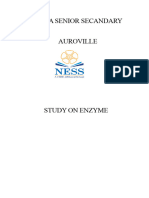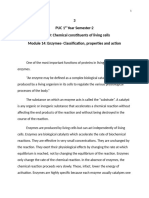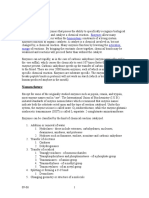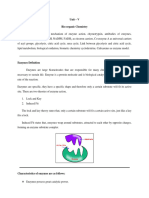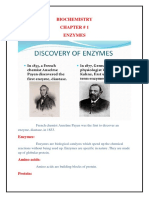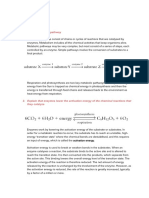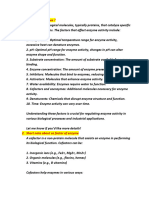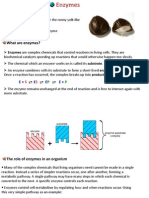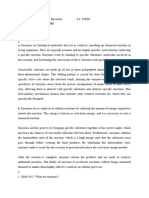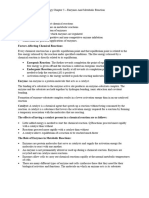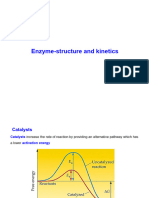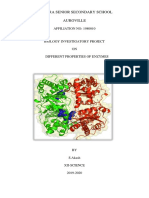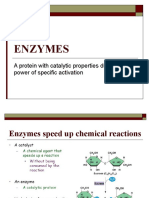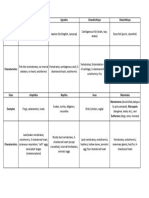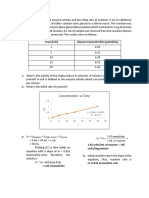Enzymes ...
Enzymes ...
Uploaded by
Glen MangaliCopyright:
Available Formats
Enzymes ...
Enzymes ...
Uploaded by
Glen MangaliCopyright
Available Formats
Share this document
Did you find this document useful?
Is this content inappropriate?
Copyright:
Available Formats
Enzymes ...
Enzymes ...
Uploaded by
Glen MangaliCopyright:
Available Formats
Enzymes
Group 4
Salud, Juan Carlo Picar, Jum Lampitoc, Raniel Famanila, Jan Joseph Mascot Delos Reyos, Laiza Joy Niog, Patricia Balibay, Martina Alexandria
Objective At the end of this unit, the student should be able to:
1. Describe enzymes including how they function, their measurement, and reporting procedures. 2. Define: a. catalyst b.active site c.substrate d.enzyme-substrate complex e.product f. cofactor g.coenzyme h.proenzyme (zymogen) i. isoenzyme 3. Contrast plasma enzymes with non-plasma enzymes. 4. List and describe six (6) classes of enzymes. 5. Explain the method of naming enzymes according to the IUB. 6. State the equation that depicts the general relationship between enzyme, substrate, and product. Overview Metabolism is the process of chemical and physical change which continually occurs in living organisms. As mentioned, chemical change occurs but not all chemical reactions occur spontaneously. Some reactions need what we call a catalyst. This catalyst enables the reaction to occur and accelerates the reaction. And such is the enzyme, they are responsible for most of the chemical reactions that take place in living organisms and hasten the process of metabolism. Metabolism is usually divided into two categories. Catabolism breaks down organic matter, for example to harvest energy in cellular respiration. Anabolism uses energy to construct components of cells such as proteins and nucleic acids. The chemical reactions of metabolism are organized into metabolic pathways, in which one chemical is transformed through a series of steps into another chemical, by a sequence of enzymes. Enzymes are crucial to metabolism because they allow organisms to drive desirable reactions that require energy and will not occur by themselves, by coupling them to spontaneous reactions that release energy. As enzymes act as catalysts they allow these reactions to proceed quickly and efficiently. Enzymes also allow the regulation of metabolic pathways in response to changes in the cell's environment or signals from other cells. The metabolism of an organism determines which substances it will find nutritious and which it will find poisonous. For example, some prokaryotes use hydrogen sulfide as a nutrient, yet this gas is poisonous to animals. The speed of metabolism, the metabolic rate, influences how much food an organism will require, and also affects how it is able to obtain that food. Enzymes large molecules that increase the rates of chemical reactions. Ribozymes enzymes made of ribonucleic acids. They catalyze the self-cleavage of certain portions of their own molecules and have been implicated in the reaction that generates peptide bonds.
Two respects of enzymes as catalysts: 1. Extremely effective, increasing reaction rates by 2. Most are extremely specific. to times.
How Enzymes Are Named and Classified: Commonly named after the reaction they catalyze and/or the compound or type of compound on which they act. The names of mostly in -ase. Some however have older names, assigned before their actions were clearly understood, such are pepsin, trypsin, and chymotrypsin all enzymes of the digestive tract. Six major groups of enzymes according to the type of reaction they catalyze: 1. Oxidoreductases catalyze oxidations and reductions.
A + B A + B In this example, A is the reductant (electron donor) and B is the oxidant (electron acceptor).
2. Transferases catalyze the transfer of a group of atoms, such as from one molecule to another.
For example, an enzyme that catalyzed this reaction would be a transferase: AX + B A + BX
3. Hydrolases catalyses hydrolysis reactions.
For example, an enzyme that catalyzed the following reaction is a hydrolase: AB + H2O AOH + BH
4. Lyases catalyze the addition of two groups to a double bond or the removal of two groups from adjacent atoms to create a double bond.
For example, an enzyme that catalyzed this reaction would be a lyase: ATP cAMP + PPi
5. Isomerases catalyze isomerization reactions.
Isomerases thus catalyze reactions of the form AB
6. Ligases (or synthetases), catalyze the joining of two molecules. Terminology Used with Enzymes:
1. Cofactors enzymes that contain non-protein portions. 2. Apoenzyme the protein (polypeptide) portion of the enzyme which until removed makes an enzyme inactive. 3. Coenzymes organic factors. 4. Substrate the compound on which the enzyme works, and whose reaction it speeds up. 5. Active site where the substrate binds to a specific portion of the enzyme during the reaction. 6. Activation any process that initiates or increases the action of an enzyme. It can be the simple addition of a cofactor to an apoenzyme or the cleavage of a polypeptide chain of a proenzyme. 7. Inhibition (opposite of activation) any process that makes an active enzyme less active or inactive. Inhibitors are compounds that accomplish this task. 8. Competitive inhibitors bind to the active site of the enzyme surface, thereby preventing the binding of substrate. 9. Noncompetitive inhibitors which bind to some other portion of the enzyme surface, may sufficiently alter the tertiary structure of the enzyme so that its catalytic effectiveness is reduced. o Both competitive and noncompetitive inhibitions are reversible, but some compounds alter the structure of the enzyme permanently and thus make it irreversibly inactive.
Factors That Influence Enzyme Activity: Enzyme activity is a measure of how much reaction rates are increased. A. Enzyme and Substrate Concentration
Substrate concentration at constant and increased enzyme concentration results in a linear increase in rate. Enzyme concentration at constant and increased substrate concentration results in a saturation curve, meaning the increase in rate will stop at a particular level.
B. Temperature
Temperature affects enzyme activity because it changes the conformation of the enzyme. In uncatalyzed reactions, the rate usually increases as the temperature increases. Changing the temperature has a different effect on enzyme-catalyzed reactions.
C. pH
The pH of the environment changes the conformation of a protein. We can expect pHrelated effects to resemble those observed with the temperature changes. Each enzyme operates best at a certain pH. Once again, within a narrow pH range, changes in enzyme activity are reversible. However, at extreme pH values (either acidic or basic), enzymes are denatured irreversibly and enzyme activity cannot be restored by changing back to the optimal pH. The Mechanisms of Enzyme Action: Arrhenius (circa 1912) suggested that catalysts speed up reactions by combining with the substrate to form some kind of intermediate compound. Enzyme-substrate complex Intermediate compound in the enzyme-catalyzed reaction. A. Lock-and-Key Model
"Lock and key" model
Enzymes are very specific, and it was suggested by the Nobel laureate organic chemist Emil Fischer in 1894 that this was because both the enzyme and the substrate possess specific complementary geometric shapes that fit exactly into one another. This is often referred to as "the lock and key" model. However, while this model explains enzyme specificity, it fails to explain the stabilization of the transition state that enzymes achieve.
Diagrams to show the induced fit hypothesis of enzyme action
In 1958, Daniel Koshland suggested a modification to the lock and key model: since enzymes are rather flexible structures, the active site is continuously reshaped by interactions with the substrate as the substrate interacts with the enzyme. As a result, the substrate does not simply bind to a rigid active site; the amino acid side-chains that make up the active site are molded into the precise positions that enable the enzyme to perform its catalytic function. In some cases, such as glycosidases, the substrate molecule also changes shape slightly as it enters the active site. The active site continues to change until the substrate is completely bound, at which point the final shape and charge is determined. Induced fit may enhance the fidelity of molecular recognition in the presence of competition and noise via the conformational proof-reading mechanism.
B. Induced-Fit Model
The cycle starts with the active site open and substrate (it could be the disaccharide sucrose) free in solution. The substrate approaches the enzyme and then binds at the active site. Substrate binding causes a change in the shape of the enzyme such that the catalytic parts of the enzyme are brought to bear on the substrate. The chemical reaction occurs and the two products are left in
the active site. If sucrose is the substrate, the two products will be glucose and fructose. The two products leave the active site and the enzyme returns to its original active site open configuration. This animation is run in slow motion. An actual enzyme catalyzed reaction occurs so quickly that enzymes can process as many as millions of substrate molecules in one second. C. Catalytic Power of Enzymes
Enzymes being extraordinary catalysts bring about 5 to 17 times order of magnitude of the rate of reaction. Much of catalytic power of enzymes is ultimately derived from the free energy released in forming many weak bonds and interactions between an enzyme and its substrate. This binding energy contributes to specificity as well as catalysis. The same binding energy for catalysis also gives an enzyme its specificity, the ability to discriminate between a substrate and a competing molecule. Emil Fisher, in 1984 proposed that enzymes were structurally complementary to their substrates, so that they fit together like a lock and key.
How Enzymes Regulate: A. Feedback control Enzymes are often regulated by environmental conditions. Feedback control is an enzyme regulation process in which formation of a product inhibits an earlier reaction in the sequence. The reaction product of one enzyme may control the activity of another, especially in a complex system in which enzymes work cooperatively.
In this illustration we can see the sequence of products as well as the reaction that happened before them. The sequence of the products are from letter A to letter D with D as the end of the sequence. In accordance to what was stated above, product D can inhibit the enzyme activity that happened before it which were represented as E2, E2 and E3. If the concentration of D is low the enzyme reactions proceed. As D accumulates the enzymes reaction are inhibited
B. Proenzymes Some enzymes are manufactured by the body in an inactive form. To make them active, a small part of their polypeptide chain must be removed. These inactive forms of enzymes are called proenzymes or zymogens. After the excess polypeptide chain is removed, the enzyme becomes active.
Since proenzymes are inactive, it means that something should be done to activate them. Biochemical changes, like hydrolysis, can activate proenzymes by cleaving off a part of the precursor enzyme which is usually a peptide unit. In this case, trypsinogen is the proenzyme and after undergoing biochemical change, a peptide unit of 6 amino acids is cleaved off resulting to an active enzyme called trypsin.
C. Alloterism Sometimes regulation takes place by means of an event that occurs at a site other than the active site but that eventually affects the active site. This type of interaction is called allosterism, and any enzyme regulated by this mechanism is called an allosteric enzyme. If a substance binds noncovalently and reversibly to a site other than the active site, it may affect the enzyme in either of the two ways: It may inhibit enzyme action (negative modulation) or it may stimulate enzyme action (positive modulation). Regulator - the substance that binds to the allosteric enzyme Regulatory site- the site to which it attaches
As we can see in the illustration, the enzyme has a secondary active site which we can refer to as the allosteric binding site. If allosteric activator bind to the allosteric site it can lead to two things. It can close the active site preventing the binding of the substrate (negative modulation) or further stimulate the binding of the substrate (positive modulation).
D. Protein Modification The activity of an enzyme may also be controlled by protein modification. The modification is usually a change in the primary structure, typically by addition of a functional
group covalently bound to the apoenzyme. The best-known example of protein modification is the activation or inhibition of enzymes by phosphorylation. A phosphate group is often bonded to a serine or tyrosine residue. In some enzymes, such as glycogen phosphorylase, the phosphorlyated form of the active form of enzyme. Without it, the enzyme would be less active or inactive.
This illustration shows the mechanism of the activation of the enzyme Pyruvate Kinase. When Pyruvate Kinase is phosphorylated it is inactive. The phosphate came from the breaking of ATP to ADP. When the activation of Pyruvate Kinase is needed, another enzyme, phosphatase, acts upon Pyruvate Kinase rendering it active.
E. Isoenzymes
Another type of regulation of enzyme activity occurs when the same enzyme appears in different forms in different tissues. Lactate dehydrogenase(LHD) catalyzes the oxidation of lactate to pyruvate, and vice versa. The enzyme has four subunits(tetrameter). Two kinds of subunits called H and M, exist. The enzyme that dominates in the heart is an enzyme, meaning that all four subunits are of the H type, although some M-type dominates. Other types of tetramer combinations exist in different tissues: . These different forms of the same enzyme are called isozymes or isoenzymes.
The table shows the different subunits of enzyme Lactate dehydrogenase on the left and the different sites in our body it can be found. The shades in the middle part of the table correspond to concentration of the subunits located in the specific site in the body. The darker the shade, the higher the concentration of the enzyme subunit in the site of the body. How Enzymes Are Used in Medicine: Abnormal enzyme activity can be used to diagnose certain diseases.
The level of enzyme activity in bodily fluids such as blood, urine, and cerebrospinal fluid can be monitored to detect diseases such as Hepatitis, Liver or Bone disease, Heart Attack and even Prostate Cancer. The abnormal activity (either high or low) of particular enzymes in various body fluids signal the onset or progression of diseases affected by theses abnormalities.
What are Transition-State Analogs and Designer Enzymes? An enzyme lowers the activation energy for a reaction, making the transition state more favorable. It does so by having an active site that actually fits the best to the transition state rather than to the substrates of the products Transition- State Analog - molecule that mimics the transition state of a chemical reaction and that is used as an inhibitor of an enzyme.
Technological application of Enzymes
Stickies Removal Enzymes are used by the pulp and paper industry for the removal of stickies, the glues, adhesives and coatings that are introduced to pulp during recycling of paper. Stickies are tacky, hydrophobic, pliable organic materials that not only reduce the quality of the final paper product, but can clog the paper mill machinery and cost hours of downtime. Chemcial methods for removal of stickies have, historically, not been 100% satisfactory. Stickies are held together by ester bonds, and the use of esterase enzymes in pulp has vastly improved their removal. Esterases cut the stickies into smaller, more water soluble compounds, facilitating their removal from the pulp. Since the early half of this decade, esterases have become a common approach to stickies control. Their limitations are, being enzymes, they are typically only effective at moderate temperature and pH. Also, certain esterases might only be effective against certain types of esters and the presence of other chemicals in the pulp can inhibit their activity. The search is on for new enzymes, and genetic modifications of existing enzymes, to broaden their effective temperature and pH ranges, and substrate capabilities.
Detergents Enzymes have been used in many kinds of detergents for over 30 years, since they were first introduced by Novozymes. Traditional use of enzymes in laundry detergents involved those that degrade proteins causing stains, such as those found in grass stains, red wine and soil. Lipases are another useful class of enzymes that can be used to dissolve fat stains and clean grease traps or other fat-based cleaning applications. Currently, a popular area of research is the investigation of enzymes that can tolerate, or even have higher activities, in hot and cold temperatures. The search for thermotolerant and cryotolerant enzymes has spanned the globe. These enzymes are especially desirable for improving laundry processes in hot water cycles and/or at low temperatures for washing colors and darks. They are also useful for industrial processes where high temperatures are required, or for bioremediation under harsh conditions (eg. in the arctic). Recombinant enzymes (engineered proteins) are being sought using different DNA technologies such as site-directed mutagenesis and DNA shuffling.
Textiles Enzymes are now widely used to prepare the fabrics that your clothing, furniture and other household items are made of. Increasing demands to reduce pollution caused by the textile industry has fueled biotechnological advances that have replaced harsh chemicals with enzymes in nearly all textile manufacturing processes. Enzymes are used to enhance the preparation of cotton for weaving, reduce impurities, minimize pulls in fabric, or as pre-treatment before dying to reduce rinsing time and improve colour quality. All of these steps not only make the process less toxic and eco-friendly, they reduce costs associated with the production process, and consumption of natural resources (water, electricity, fuels), while also improving the quality of the final textile product.
Foods and Beverages This is the domestic application for enzyme technology that most people are already familiar with. Historically, humans have been using enzymes for centuries, in early biotechnological practices, to produce foods, without really knowing it. It was possible to make wine, beer, vinegar and cheeses, for example, because of the enzymes in the yeasts and bacteria that were utilized. Biotechnology has made it possible to isolate and characterize the specific enzymes responsible for these processes. It has allowed the development of specialized strains for specific uses that improve the flavour and quality of each product. Enzymes can also be used to make the process cheaper and more predictable, so a quality product is ensured with every batch brewed. Other enzymes reduce the length of time required for aging, help clarify or stabilize the product, or help control alcohol and sugar contents. For years, enzymes have also been used to turn starch into sugar. Corn and wheat syrups are used throughout the food industry as sweeteners. Using enzyme technology, the production of these sweeteners can be less expensive than using sugarcane sugar. Enzymes have been developed and enhanced using biotechnological methods, for every step of the process.
References http://www.worthington-biochem.com/introbiochem/lifeProcesses.html http://library.thinkquest.org/28751/review/biochem/7.html http://biotech.about.com/od/glossary/g/Enzyme.htm http://www.elmhurst.edu/~chm/vchembook/570enzymes.html http://www.sciencedirect.com/science/article/pii/S0014579306003760 http://www.scienceforums.net/topic/26941-enzymes-and-feedback-control/ http://biochemistryquestions.wordpress.com/2008/07/15/induced-fit-model-of-enzyme-substrateinteraction/ http://en.wikibooks.org/wiki/Structural_Biochemistry/Enzyme/Active_Site http://biotech.about.com/od/whatisbiotechnology/a/EverydayEnzymes.htm
You might also like
- Biology: a QuickStudy Laminated Reference GuideFrom EverandBiology: a QuickStudy Laminated Reference GuideRating: 3 out of 5 stars3/5 (2)
- C9e Answers Active Reading 08Document7 pagesC9e Answers Active Reading 08melissa_chow_1100% (6)
- HW 1Document1 pageHW 1JamesNo ratings yet
- 121514382Document10 pages121514382nejraelmaaidaNo ratings yet
- 4 - EnzymesDocument31 pages4 - EnzymescheckmateNo ratings yet
- Lecture On EnzymesDocument26 pagesLecture On EnzymesDAVIE MATIASNo ratings yet
- En ZymologyDocument9 pagesEn Zymologychrispusadriko4No ratings yet
- Microsoft Word - Chapter 3Document4 pagesMicrosoft Word - Chapter 3hjhjkhdsafNo ratings yet
- Chapter-6.1-Enzymes-and-metabolism-2Document6 pagesChapter-6.1-Enzymes-and-metabolism-2ebitnercristineNo ratings yet
- Final Study On EnzymeDocument9 pagesFinal Study On Enzymerosariopraveen007No ratings yet
- Study On EnzymesDocument21 pagesStudy On EnzymesPragyan Kumar PradhanNo ratings yet
- Enzymes Mbc213Document13 pagesEnzymes Mbc213prosperosamegieNo ratings yet
- AP BIO Febraury Break With AnswersDocument12 pagesAP BIO Febraury Break With AnswersMehak BectorNo ratings yet
- Biology ProjectDocument41 pagesBiology ProjectGanesan Siva67% (12)
- EnzymesDocument22 pagesEnzymeslovelykissNo ratings yet
- Enzymes: Biochemistry BCH 211Document20 pagesEnzymes: Biochemistry BCH 211Eniola JayeolaNo ratings yet
- Enzyme ClassificationDocument8 pagesEnzyme ClassificationR.KRISHNA KUMARINo ratings yet
- 4 5802889532911126912Document68 pages4 5802889532911126912DanielNo ratings yet
- S.5 EnzymesDocument16 pagesS.5 EnzymesmasemvirginNo ratings yet
- Enzymes: Enzymes Homeostasis Activation EnergyDocument6 pagesEnzymes: Enzymes Homeostasis Activation EnergyGowthami MarreddyNo ratings yet
- Asma AssignmentDocument43 pagesAsma AssignmentA TECHNo ratings yet
- Bio-Organic Chemistry (Unit-V)Document32 pagesBio-Organic Chemistry (Unit-V)PG ChemistryNo ratings yet
- 2 General Biochemistry Author Federal University of Agriculture, AbeokutaDocument7 pages2 General Biochemistry Author Federal University of Agriculture, AbeokutaChris MadsenNo ratings yet
- The Nature, Properties and Classifiication Ofi Enzymes and CofiactorsDocument24 pagesThe Nature, Properties and Classifiication Ofi Enzymes and CofiactorsuagboladeNo ratings yet
- Biochemistry Chapter # 1 EnzymesDocument10 pagesBiochemistry Chapter # 1 EnzymesUsman AhmadNo ratings yet
- Enzyme ChemistryDocument9 pagesEnzyme ChemistryVictor OmoloNo ratings yet
- icpUNIT 4Document8 pagesicpUNIT 4frankyupi22No ratings yet
- enzymesDocument13 pagesenzymesTebula ShilahoNo ratings yet
- ENZYMES NOTES (Recovered)Document10 pagesENZYMES NOTES (Recovered)zipporahwaithera404No ratings yet
- Lecture Notes in Medical Technology - Lecture #11 - EnzymologyDocument22 pagesLecture Notes in Medical Technology - Lecture #11 - EnzymologyKat JornadalNo ratings yet
- Enzyme: Enzymes AreDocument11 pagesEnzyme: Enzymes ArePiyush BhallaNo ratings yet
- Metabolism (HL)Document26 pagesMetabolism (HL)Sapreen KaurNo ratings yet
- EnzymologyDocument15 pagesEnzymologybilalad408No ratings yet
- Jessica Lee Enzyme LabDocument15 pagesJessica Lee Enzyme LabAshalee JonesNo ratings yet
- Enzymes - Lecture NotesDocument8 pagesEnzymes - Lecture NotesssekitoolekohakimNo ratings yet
- GCE AS Biology 3 ENZYME NoteDocument11 pagesGCE AS Biology 3 ENZYME Notengnicole090607No ratings yet
- Unit 6: Enzymes: Image Modified From " ," by Openstax College, BiologyDocument4 pagesUnit 6: Enzymes: Image Modified From " ," by Openstax College, BiologyAbraham BanjoNo ratings yet
- Biochem - Enzymes Report ScriptDocument5 pagesBiochem - Enzymes Report ScriptIan IglesiaNo ratings yet
- Factors of EnzymesDocument13 pagesFactors of Enzymeshowto7470No ratings yet
- What Are Enzymes?: E E E EDocument15 pagesWhat Are Enzymes?: E E E EFarhana MuradNo ratings yet
- Enzymes 1Document6 pagesEnzymes 1zarszNo ratings yet
- EnzymeDocument39 pagesEnzymexehala111No ratings yet
- Cell Bio Chapter 6Document32 pagesCell Bio Chapter 6GuteNo ratings yet
- S.5 EnzymesDocument16 pagesS.5 Enzymesmusokelukia6No ratings yet
- Lecture 5 Enzymes ChemistryDocument15 pagesLecture 5 Enzymes Chemistryسجاد رياض مشروم جبارNo ratings yet
- EnzymesDocument42 pagesEnzymescimdesadesuNo ratings yet
- General Biology: Peralta III Edwin C. STEM-GalileoDocument10 pagesGeneral Biology: Peralta III Edwin C. STEM-GalileoSavage CabbageNo ratings yet
- EnzymesDocument13 pagesEnzymesabi660462No ratings yet
- EnzymesDocument3 pagesEnzymessashi bNo ratings yet
- Biology - EnzymesDocument14 pagesBiology - Enzymesbittuwhite21No ratings yet
- BIOLOGY Chapter 3 - EnzymesDocument5 pagesBIOLOGY Chapter 3 - Enzymeschelsea AlexandriaNo ratings yet
- Enzyme Kinetics Lecture NoteDocument51 pagesEnzyme Kinetics Lecture Notedowndstairs45No ratings yet
- Biochemistry: By: Angela Marie Ferrer BSN 2BDocument13 pagesBiochemistry: By: Angela Marie Ferrer BSN 2BNoemi Martinez FerrerNo ratings yet
- Enzymology Basics PDFDocument72 pagesEnzymology Basics PDFMae AnnNo ratings yet
- EnzymesDocument3 pagesEnzymesArabela SimanganNo ratings yet
- Chapter 02 EnzymesDocument8 pagesChapter 02 Enzymesmiraniwaqar16No ratings yet
- Akasg Biology Investigatory Project 12Document14 pagesAkasg Biology Investigatory Project 12kanishkaran80% (5)
- En ZymologyDocument7 pagesEn Zymologyhowto7470No ratings yet
- Enzymes: A Protein With Catalytic Properties Due To Its Power of Specific ActivationDocument35 pagesEnzymes: A Protein With Catalytic Properties Due To Its Power of Specific ActivationAkash SinghNo ratings yet
- A-level Biology Revision: Cheeky Revision ShortcutsFrom EverandA-level Biology Revision: Cheeky Revision ShortcutsRating: 5 out of 5 stars5/5 (5)
- Conducting Research - Glen Mangali - Letran - 2017 PDFDocument237 pagesConducting Research - Glen Mangali - Letran - 2017 PDFGlen MangaliNo ratings yet
- Chordate Classes ChartDocument1 pageChordate Classes ChartGlen MangaliNo ratings yet
- (SHARED) Google Certified Educator L1 and L2 Exam FAQsDocument2 pages(SHARED) Google Certified Educator L1 and L2 Exam FAQsGlen MangaliNo ratings yet
- Conducting Research - SIP - RIM - 2019Document170 pagesConducting Research - SIP - RIM - 2019Glen MangaliNo ratings yet
- 21st Century Teaching and Learning - GlenMangaliDocument228 pages21st Century Teaching and Learning - GlenMangaliGlen Mangali100% (2)
- Conducting Research - Glen Mangali - Letran - 2017Document237 pagesConducting Research - Glen Mangali - Letran - 2017Glen Mangali100% (2)
- Conducting Research - Glen Mangali - Letran - 2017 PDFDocument237 pagesConducting Research - Glen Mangali - Letran - 2017 PDFGlen MangaliNo ratings yet
- Innovative Teaching Strategies For TUP Graduate SchoolDocument220 pagesInnovative Teaching Strategies For TUP Graduate SchoolGlen Mangali100% (8)
- Chapter 3Document79 pagesChapter 3Glen MangaliNo ratings yet
- Chapter 3 and 4 Nutrition, Culture and EnzymesDocument173 pagesChapter 3 and 4 Nutrition, Culture and EnzymesGlen MangaliNo ratings yet
- Glen R. Mangali, Et. Al: Philippine Association of Researchers and Statistical Software Users (Parssu)Document1 pageGlen R. Mangali, Et. Al: Philippine Association of Researchers and Statistical Software Users (Parssu)Glen MangaliNo ratings yet
- 2013 ICIRI Oral Presentation Criteria PDFDocument2 pages2013 ICIRI Oral Presentation Criteria PDFGlen Mangali100% (1)
- Glen R. Mangali, MS: Colegio de San Juan de LetranDocument1 pageGlen R. Mangali, MS: Colegio de San Juan de LetranGlen MangaliNo ratings yet
- Glen R. Mangali, Et. Al: Philippine Association of Researchers and Statistical Software Users (Parssu)Document1 pageGlen R. Mangali, Et. Al: Philippine Association of Researchers and Statistical Software Users (Parssu)Glen MangaliNo ratings yet
- Mangali, Chin, Dabasol, Habana, Sabojocan, Shinotsuka, Taguba PDFDocument1 pageMangali, Chin, Dabasol, Habana, Sabojocan, Shinotsuka, Taguba PDFGlen MangaliNo ratings yet
- Mangali, Jennifer PDFDocument1 pageMangali, Jennifer PDFGlen MangaliNo ratings yet
- IMRAD Lecture of Ma'Am Golda 2Document89 pagesIMRAD Lecture of Ma'Am Golda 2Glen Mangali100% (2)
- 2 Enzymes & Enzyme KineticsDocument37 pages2 Enzymes & Enzyme KineticsNovVie VietTha Sccor IINo ratings yet
- Module 4 - Enzymes 1 PDFDocument14 pagesModule 4 - Enzymes 1 PDFFrancis ValdezNo ratings yet
- Enzymes The Catalysts of LifeDocument43 pagesEnzymes The Catalysts of LifeKelsey WhitmoreNo ratings yet
- J. Biol. Chem. 1961 Rajagopalan 1059 65Document8 pagesJ. Biol. Chem. 1961 Rajagopalan 1059 65Cyrene MBolañosNo ratings yet
- Enzyme NotesDocument3 pagesEnzyme NotesJanin CodillaNo ratings yet
- Enzyme Activity Online LabDocument5 pagesEnzyme Activity Online LabJohn BuzzerioNo ratings yet
- Plant-Physiology by TAIZ and ZEIGER PDFDocument2 pagesPlant-Physiology by TAIZ and ZEIGER PDFshxxxNo ratings yet
- Bio Synthesis of Fatty AcidsDocument15 pagesBio Synthesis of Fatty Acidspriya19866No ratings yet
- Biological OxidationDocument6 pagesBiological OxidationNischal DhNo ratings yet
- Biology Notes CHPTR 5Document4 pagesBiology Notes CHPTR 5Wan HasliraNo ratings yet
- R11. Enzymes and Other Proteins: Henedina A. Maini, RPH LecturerDocument33 pagesR11. Enzymes and Other Proteins: Henedina A. Maini, RPH LecturerChyra OrpillaNo ratings yet
- Chapter 16 PDFDocument15 pagesChapter 16 PDFnavanitamganesonNo ratings yet
- 11 GlycolysisDocument51 pages11 GlycolysisGianna Kristen MirandaNo ratings yet
- JJDocument4 pagesJJEureca ParraNo ratings yet
- EnzymesDocument6 pagesEnzymesSarah Farhah2000100% (1)
- LipogenesisDocument30 pagesLipogenesisjzllfrncscNo ratings yet
- O Level BiologyDocument2 pagesO Level Biology⟬⟭ ⟭⟬No ratings yet
- Food Chemistry - Activity 2Document3 pagesFood Chemistry - Activity 2Leda PeñaNo ratings yet
- Krebs (Citric Acid) Cycle Steps by Steps ExplanationDocument5 pagesKrebs (Citric Acid) Cycle Steps by Steps ExplanationNaeem KhanNo ratings yet
- Siklus Asam Sitrat PDFDocument27 pagesSiklus Asam Sitrat PDFLuses Shantia HaryantoNo ratings yet
- TSAI HSIANG en Biochemical EngineeringDocument22 pagesTSAI HSIANG en Biochemical EngineeringTSAI, HSIANGEN(대학원학생/일반대학원 화공생명공학) No ratings yet
- Kinetic Analysis of TyrosinaseDocument7 pagesKinetic Analysis of TyrosinaseJoão AlvesNo ratings yet
- 6.metabolisme Lipid PDFDocument40 pages6.metabolisme Lipid PDFSYITA SHEVIA PRASASTINo ratings yet
- EnzymeDocument16 pagesEnzymeAndreNo ratings yet
- EnzymesDocument60 pagesEnzymesRia Alcantara100% (1)
- Kreb-Cycle-StryerDocument34 pagesKreb-Cycle-StryerAngelikaOdimerNo ratings yet
- Enzyme WorksheetDocument3 pagesEnzyme Worksheetchinmayee chitturu100% (1)
- Lecture 2PBEDocument44 pagesLecture 2PBEJawadNo ratings yet










